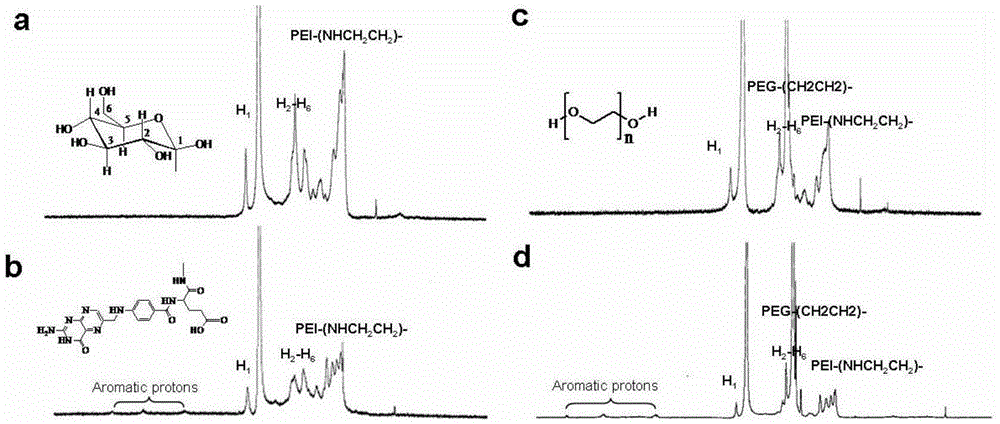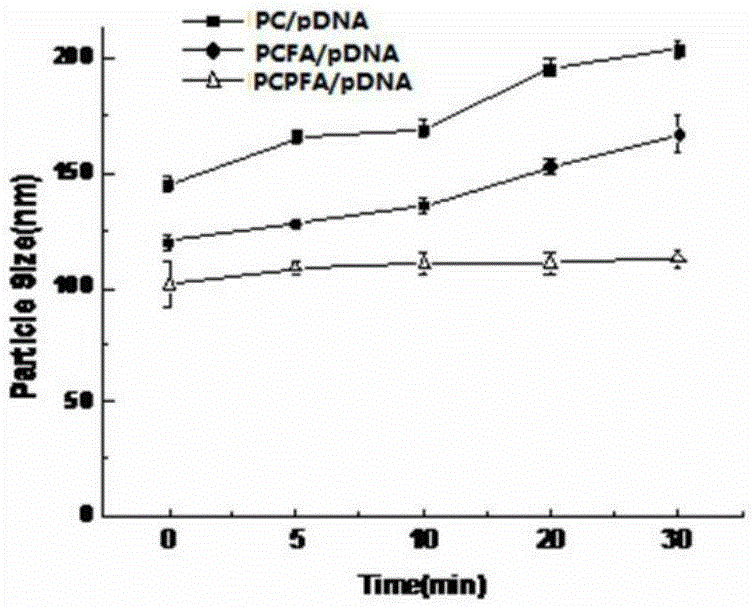Nano particle composition and anti-tumor application thereof
A nanoparticle and composition technology, which is applied in the direction of antineoplastic drugs, non-active ingredients of polymer compounds, drug combinations, etc., can solve the problems of increasing treatment costs and affecting the effect of treatment, so as to prolong life or survival time, prevent Metastasis or recurrence and the effect of reducing mortality
- Summary
- Abstract
- Description
- Claims
- Application Information
AI Technical Summary
Problems solved by technology
Method used
Image
Examples
Embodiment 1
[0027] 1. Preparation of PEI-CyD-PEG-FA
[0028] A previous patent synthesized a polycationic carrier (named H1) that uses cyclodextrin (CyD) as a cross-linked backbone, connects low-molecular-weight polyethyleneimine (PEI), and couples a small-molecule drug folic acid with tumor targeting specificity. ). H1 has been proved to be able to encapsulate and concentrate the plasmid expressing the target gene into a nanoparticle with a size of about 100 nanometers in a liquid environment. In a variety of tumor cell lines, this nanoparticle showed low toxicity, high efficiency and target-specific gene delivery ability. Treatment of cancer, particularly malignant melanoma, using H1-transduced nanoparticles expressing anti-tumor cytokines.
[0029] Polyethylene glycol (PEG) is a hydrophilic polymer, which can improve the hydrophilicity of the surface of colloidal particles and the stability of ionic solutions, thereby reducing the complement conditioning and the removal of the reticu...
Embodiment
[0048] Example: 48 Balb / c mice According to the method described in the preliminary experiment, an orthotopic liver cancer mouse experimental animal model inoculated with ML-1 cells was established. Seven days after the operation, the mice were randomly divided into 5 groups, 12 mice in each group, and were given intraperitoneal injection of PCPFA / pLuc (DNA 100ug) and PCPFA / pLuc (DNA 100ug) respectively. One month after treatment, 4 mice were randomly selected from each group to extract tumor tissue, weighed and collected for subsequent mechanism studies; the remaining mice continued to be observed for survival studies.
[0049] The results showed that: 30 days after treatment, the median weight of tumor tissue in the PCPFA / pLuc treatment group was 520 mg; in the PCPFA / pHGFK1 treatment group, the median weight of tumor tissue was 180 mg. This indicated that PCPFA / pHGFK1 treatment significantly inhibited the growth of liver orthotopic inoculated tumors. attached Figure 6 It ...
PUM
| Property | Measurement | Unit |
|---|---|---|
| Diameter | aaaaa | aaaaa |
| Particle size | aaaaa | aaaaa |
Abstract
Description
Claims
Application Information
 Login to View More
Login to View More - R&D
- Intellectual Property
- Life Sciences
- Materials
- Tech Scout
- Unparalleled Data Quality
- Higher Quality Content
- 60% Fewer Hallucinations
Browse by: Latest US Patents, China's latest patents, Technical Efficacy Thesaurus, Application Domain, Technology Topic, Popular Technical Reports.
© 2025 PatSnap. All rights reserved.Legal|Privacy policy|Modern Slavery Act Transparency Statement|Sitemap|About US| Contact US: help@patsnap.com



